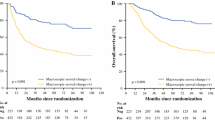Abstract
Background
The aim of this study was to evaluate the clinical implication of serosal change in pathologic subserosa-limited gastric cancer based on a retrospective analysis.
Methods
A total of 285 patients who were diagnosed with pathologically subserosa-limited gastric cancer were included. The patients were divided into two groups: the accordance group, with subserosa-limited cancer without macroscopic serosa change (n = 124); the discordance group, with subserosa-limited cancer showing macroscopic serosal change (n = 161).
Results
Tumor size, number of metastatic lymph nodes, and pathologic N stage were significantly associated with macroscopic serosal change. Serosal change patients presented a higher recurrence rate compared with patients without serosal change (38.0 vs. 20.2% for the 5-year recurrence rate, P = 0.002), and peritoneal seeding presented frequently in serosal-change patients with significance (41.1%). Likewise, the overall survival of serosal-change patients was significantly worse than that for those without serosal change (66.9 vs. 81.4% for the 5-year survival rate, P = 0.002). Serosal change was an independent prognostic factor for overall survival (relative risk 1.784, P = 0.039).
Conclusions
Serosal change in pathologic subserosa-limited gastric cancer is related to poor survival. Therefore, adjuvant chemotherapy should be considered for these patients, and adequate follow-up programs instituted for early detection of peritoneal seeding.




Similar content being viewed by others
References
Ludeman L, Shepherd NA (2005) Serosal involvement in gastrointestinal cancer: its assessment and significance. Histopathology 47:123–131
Arends J (2010) Metabolism in cancer patients. Anticancer Res 30:1863–1868
Folkman J (1995) Angiogenesis in cancer, vascular, rheumatoid and other disease. Nat Med 1:27–31
Carmeliet P, Jain RK (2000) Angiogenesis in cancer and other diseases. Nature 407:249–257
Lin EY, Nguyen AV, Russell RG et al (2001) Colony-stimulating factor 1 promotes progression of mammary tumors to malignancy. J Experim Med 193:727–740
Bando E, Kawamura T, Kinoshita K et al (2003) Magnitude of serosal changes predicts peritoneal recurrence of gastric cancer. J Am Coll Surg 197:212–222
Abe S, Shiraishi M, Nagaoka S et al (1991) Serosal invasion as the single prognostic indicator in stage III A (T3N1M0) gastric cancer. Surgery 109:582–588
Baba H, Korenaga D, Haraguchi M et al (1989) Width of serosal invasion and prognosis in advanced human gastric cancer with special reference to the mode of tumor invasion. Cancer 64:2482–2486
Boku T, Nakae Y, Minoura T et al (1990) Prognostic significance of serosal invasion and free cancer cell in gastric cancer. Br J Surg 77:436–439
Moriguchi S, Maehara Y, Korenaga D et al (1992) Risk factors which predict pattern of recurrence after curative surgery for patients with advanced gastric cancer. Surg Oncol 1:341–346
Yun WS, Kim TB, Yu WS (2006) Macroscopic serosal invasion in advanced gastric cancer. J Korean Gastric Cancer Assoc 6:84–90
Suzuki A, Togashi K, Nokubi M et al (2009) Evaluation of venous invasion by elastica van Gieson stain and tumor budding predicts local and distant metastases in patients with T1 stage colorectal cancer. Am J Surg Pathol 33:1601–1607
Shibuya K, Mathers CD, Boschi-Pinto C et al (2002) Global, regional estimates of cancer mortality, incidence by site. II. Results for the global burden of disease 2000. BMC Cancer 26:37
CentralCancer Registry in Korea (2007) 2002 Annual report of the central cancer registry in Korea. Ministry of Health and Welfare, Seoul
GASTRIC (global advanced/adjuvant stomach tumor research international collaboration) Group, Paoletti X, Oba K et al (2010) Benefit of adjuvant chemotherapy for resectable gastric cancer: a meta-analysis. JAMA 303:1729–1737
Glehen O, Mohamed F, Gilly FN (2004) Peritoneal carcinomatosis from digestive tract cancer: new management by cytoreductive surgery and intraperitoneal chemohyperthermia. Lancet Oncol 5:219–228
Roviello F, Marrelli D, de Manzoni G et al (2003) Prospective study of peritoneal recurrence after curative surgery for gastric cancer. Br J Surg 90:1113–1119
Korenaga D, Okuyama T, Orita H et al (1994) Role of intraoperative assessment of lymph node metastasis and serosal invasion in patients with gastric cancer. J Surg Oncol 55:250–254
Nakagawa S, Nashimoto A, Yabusaki H (2007) Role of staging laparoscopy with peritoneal lavage cytology in the treatment of locally advanced gastric cancer. Gastric Cancer 10:29–34
Osorio J, Rodríguez-Santiago J, Muñoz E et al (2008) Outcome of unresected gastric cancer after laparoscopic diagnosis of peritoneal carcinomatosis. Clin Trans Oncol 10:294–297
Ichiyoshi Y, Maehara Y, Tomisaki S et al (1995) Macroscopic intraoperative diagnosis of serosal invasion and clinical outcome of gastric cancer: risk of underestimation. J Surg Oncol 59:255–260
Kuper H, Adami HO, Trichopoulos D (2000) Infections as a major preventable cause of human cancer. J Int Med 248:171–183
Baron JA, Sandler RS (2000) Nonsteroidal anti-inflammatory drugs and cancer prevention. Annu Rev Med 51:511–523
Garcia Rodriguez LA, Huerta-Alvarez C (2001) Reduced risk of colorectal cancer among long-term users of aspirin and nonaspirin nonsteroidal anti-inflammatory drugs. Epidemiology 12:88–93
Nitti D, Marchet A, Mocellin S et al (2009) Prognostic value of subclassification of T2 tumours in patients with gastric cancer. Br J Surg 96:398–404
Kumagai K, Shimitzu K, Yokoyama N et al (2010) Gastrointestinal cancer metastasis and lymphatic advancement. Surg Today 40:301–306
Sleeman JP, Krishnan J, Kirkin V et al (2001) Markers for the lymphatic endothelium: in search of the holy grail? Microsc Res Technol 55:61–69
Acknowledgments
We thank Dr. Jung for designation and assistance on the draft and statistical analyses.
Conflicts of interest
The authors declare that there are no actual or potential conflicts of interest.
Author information
Authors and Affiliations
Corresponding author
Rights and permissions
About this article
Cite this article
Kim, J.M., Jung, H., Lee, J.S. et al. Clinical Implication of Serosal Change in Pathologic Subserosa-Limited Gastric Cancer. World J Surg 36, 355–361 (2012). https://doi.org/10.1007/s00268-011-1334-x
Published:
Issue Date:
DOI: https://doi.org/10.1007/s00268-011-1334-x




